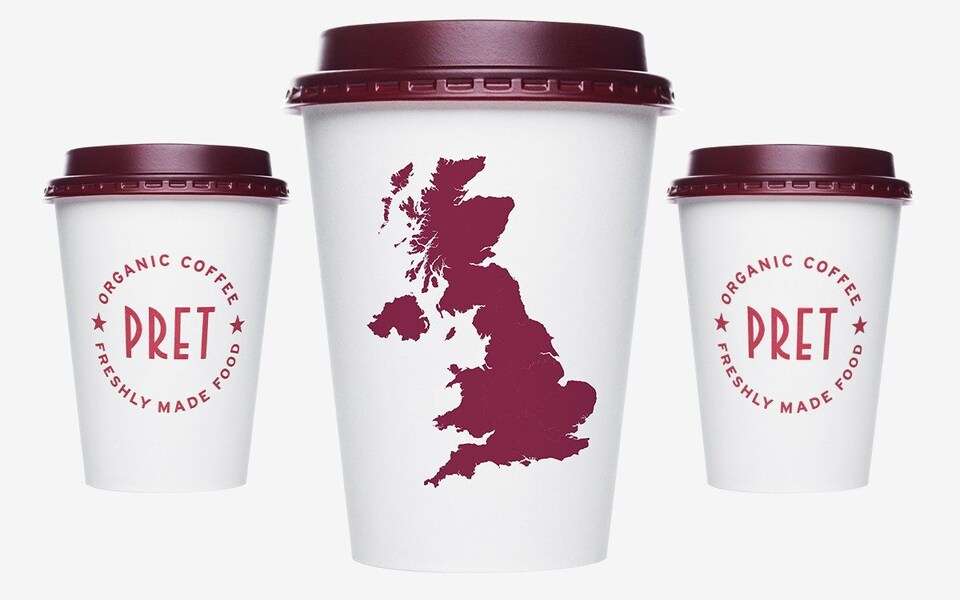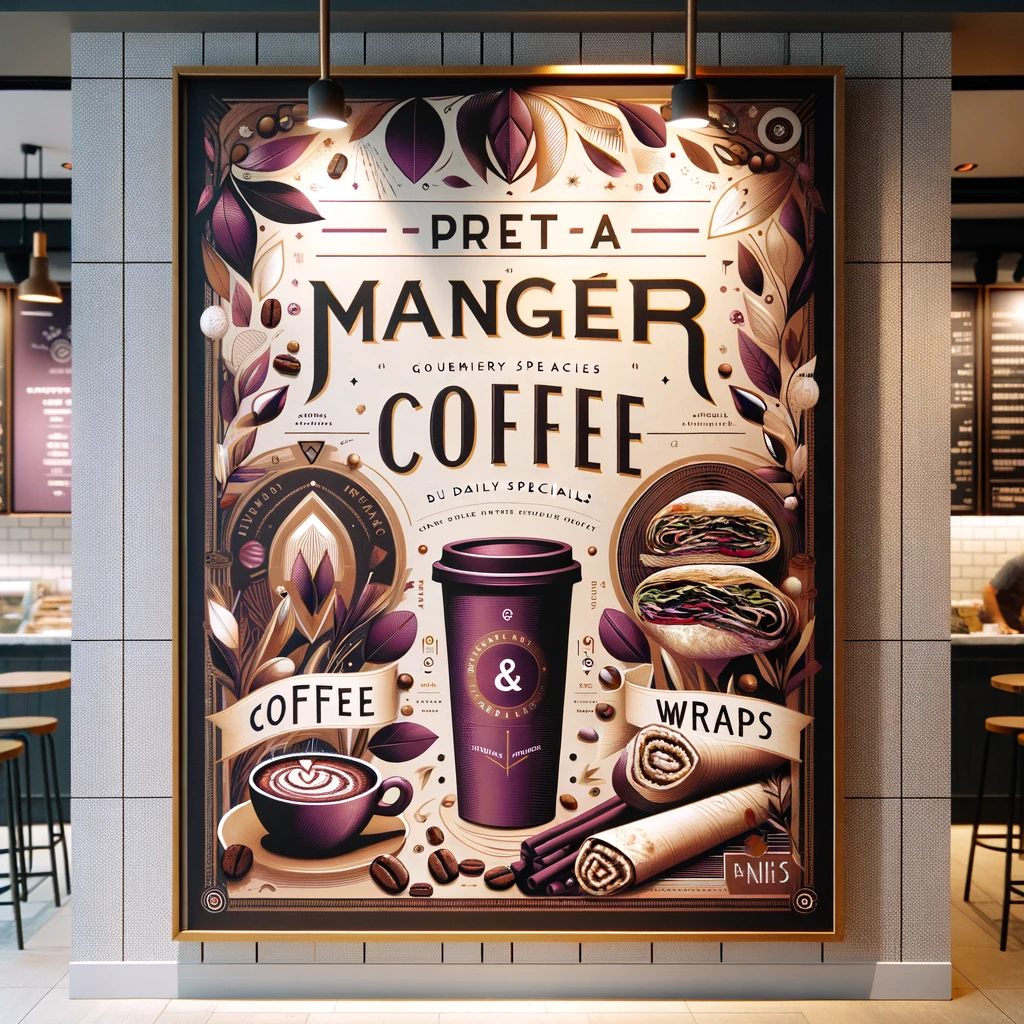Pret A Manger: An In-Depth Analysis of One of the UK’s Best-Loved Sandwich Shop Franchises
Alex Greve
November 28, 2023
Let’s take a look at the grab-and-go strategies that have positioned Pret A Manger as one of the leading sandwich and coffee shops in the UK and what might be areas for improvement – a comprehensive analysis of their successes, challenges, and business genius.
Introduction
In the vibrant, bustling streets of the UK, one name often comes to mind when you crave a quick and healthy meal on the go: Pret A Manger. This well-established grab-and-go eatery has been working its way into the hearts of food enthusiasts since 1986, when they opened their first shop on 75B Victoria Street in London.
But what is the recipe behind their success? And why are they so well-loved by the UK’s corporate culture? What could they do better to improve their status even further? Let’s take a look at Pret A Manger UK and discuss their strengths, weaknesses, and any room for improvement.
A look back at where Pret A Manger began
Pret A Manger opened its doors in 1986 at 75B Victoria Street, London, setting the stage for a culinary revolution that redefined lunchtime for office workers across the UK. The simple quest for a “proper sandwich” motivated co-founders Julian Metcalfe and Sinclair Beecham to embark on this journey. It inspired them to purchase the branding from a liquidated shop in Hampstead. The historical images of that inaugural store capture a Romanesque abundance, reminiscent of a New York deli, portraying the roots of a brand that would soon blossom.
In its infancy, Pret’s impact was modest, selling around 12 coffees a day, but its innovative approach to quick service and the creation of freshly made sandwiches soon resonated with a growing clientele. Particularly those in the corporate world who wanted fast, fresh lunches on the go. However, it took three years before the company was ready to unveil its second store. By 1998, Pret had burgeoned to over 50 locations, welcoming a staggering 20 million customers annually who devoured 14 million sandwiches and drank ten million cups of coffee. The following years saw exponential growth, with the coffee count skyrocketing to 1.4 million per day by 2017.
Despite expanding its footprint to international destinations such as Shanghai, Dubai, Singapore, Paris, and New York, Pret A Manger retained a profound connection to its birthplace, London. Just before the pandemic’s disruption, the franchise boasted over 400 shops in the UK, with 300 of them nestled in the bustling streets of the capital. This brings into question whether the franchise expects to expand to more towns and rural parts of the UK or if it is secure enough to only remain in the most affluent cities.

Pret’s commitment to culinary excellence is evident in its diverse menu. Featuring bakery items like baguettes, croissants, and cookies. While these delectables aren’t crafted from scratch in individual shops, they are freshly baked in the central kitchens throughout the day. Every item on the Pret menu, whether made on-site or delivered ready to sell, is a testament to the passion for good food that defines the brand. The emphasis on daily preparation ensures that there are no ‘sell by’ dates on their fresh sandwiches and salads, embodying the enduring commitment to quality that has made Pret A Manger a beloved fixture in the hearts and lunch plans of many.
So what has Pret A Manger done to ensure its reputation has remained one of the UK’s best-loved lunch spots throughout the years, and what has enabled them to continue to be successful despite fierce competition and even economic struggles? Are there some areas they have not done so well in? Let’s find out.
We’re now going to take a look at the secrets behind Pret A Manger becoming such a pinnacle in the grab-and-go lunch and coffee industry and what they could improve upon to keep them at the top of their game and remain as one of the most delicious, unique sandwich spots in the UK.
First, let’s take a look at their current marketing, customer retention strategies, and how they utilise social media.
Here we will explore Pret a Manger’s journey of innovation and expansion. From their subscription and loyalty schemes to whether they cater to different ethnic cuisines. How they crowdsource new products on social media, as well as how they showcase their commitment to quality, adaptability, and staying relevant in a fiercely competitive industry.
Pret A Manger Loyalty Schemes are Customer Retention Gold
Initially conceived as a lifeline during the challenging times of the pandemic, Pret A Manger’s subscription service has proven to be a cornerstone of its recent success. Extending its influence beyond those uncertain days, the appeal of the membership offer played a pivotal role in the brand’s resurgence, catapulting it back into profitability in 2022 after a four-year slump. As Pret’s subscription model matures, the focal point of its strategy is evolving, with a heightened emphasis on customer retention.
Becci Dive, Pret’s UK head of marketing, values the growing importance of subscriber retention, highlighting the importance of leveraging Club Pret data for personalised experiences. In her words, “Now that we’ve got a really stable base of people that are a part of Club Pret, how do we personalise that?” This commitment to personalisation aligns seamlessly with Pret’s loyalty-centric approach, exemplified by the expansion of its Coffee Subscription into a comprehensive loyalty programme known now as ‘Club Pret.’
Under this revamped loyalty scheme, subscribers enjoy substantial benefits, including a 20% discount on all in-store purchases, covering freshly made food, snacks, and drinks. Priced at £30 per month, with a half-price offer in the inaugural month, subscribers can get up to five barista-prepared drinks daily – this is a huge saving of up to £72.82 per week!

However, for those not seeking to consume 5 cups of coffee per day and instead are just looking for a daily breakfast-on-the-go or a speedy lunch hour, the discounts aren’t as lucrative. For a patron seeking 1 Americano, a baguette, and a cookie, the total would be £8.56 per day with the subscription. Although there are still considerable savings of £141.20 per month, (based on 1 meal and coffee per day for 5 days per week) it doesn’t match up to the mammoth savings of £291.28 if they were to make use of the five barista-prepared drinks included.
Could they improve this by offering a fresh sandwich or even a cookie to go along with the 5 allocated coffees or even in place of? Or a weekly incentive of a mid-week meal deal?
The Club Pret initiative does mark a significant evolution in Pret’s loyalty strategy, reinvesting in its most devoted customer base and team members. This strategic move follows the resounding success of the Pret Coffee Subscription, which witnesses a remarkable redemption rate of 1.25 million times per week, marking an 11% year-on-year increase.
Since April 26, 2023, Pret A Manger has been taking a bold step forward in loyalty investment, broadening the scope of Club Pret to encompass not only beverages but also all freshly made food items and snacks. This move exemplifies Pret’s commitment to rewarding its loyal customers, ensuring they feel valued and appreciated. The integration of personalisation into the Club Pret experience further reflects the brand’s dedication to meeting individual preferences, placing loyalty at the forefront of its mission.
Brand and Marketing Genius.
The brand’s recent unveiling of its visual identity and purpose solidifies its global expansion and ongoing digital evolution. The brand’s purpose, ‘To make every day a little bit brighter,’ encapsulates their vision to infuse joy into every interaction. The dual meaning of their new tagline, ‘Pret. Makes Every Day,’ cleverly reinforces the freshness of its handmade products while emphasising the integral role Pret plays in customers’ daily routines.
In collaboration with creative agency JKR, Pret’s new branding is crafted to be more accessible, uplifting, and welcoming. The aesthetic shift aims for a contemporary and distinctive feel, resonating with the brand’s ethos. This revamped identity is set to permeate Pret’s global markets, spanning digital assets, packaging, products, uniforms, and stores.
The brand refresh coincides with Pret’s rapid growth, which has been characterized by new store openings and forays into international franchise partnerships. From the launch of the Pret Coffee Subscription and the Pret app to expanded delivery services and the pilot of the Pret Perks loyalty scheme, Pret A Manger stands at the forefront of adapting to the changing habits of customers and marketing trends. Pret A Manger’s branding and marketing reveal a strategic focus. Aiming to achieve 50% digital orders in the coming years, their commitment to digital transformation is clearly evident.
Product Innovations
Pret A Manger appears to be committed to providing a diverse range of menu options, namely vegetarian and vegan. From the “Meatless Meatball” Wrap to the vegan “Chilli Enchilada” plant-based enthusiasts can indulge in a variety of flavorful options. However, what seems to be lacking is more ethnic cuisine options. As it currently stands, Pret A Manger does not offer Halal or Kosher-certified products on their menu. A Pret spokesperson clarified that the absence of certification stems from the varied sources of ingredients, with many not adhering to Halal standards. While meat and chicken predominantly hail from the UK, certain speciality items like prosciutto and chorizo are sourced from Italy and Spain. The meat used, however, does not undergo Halal or Kosher slaughter techniques. Not catering to these unique ethnic needs is a missed opportunity to further diversify their menus.
In terms of innovation, Pret A Manger has displayed strategic prowess by engaging with its audience through social media to shape its menu. Notably, the launch of Veggie Pret, a vegetarian and vegan-focused shop, originated from a poll that garnered over 10,000 votes, with 44% advocating for the establishment of a ‘Veggie Shop.’ This successful initiative, born as an experimental pop-up in 2016, gained permanence due to overwhelmingly positive reviews and sales, and now boasts multiple locations.
The brand’s use of crowdsourcing ideas from the public continued as it expanded its vegan menu and introduced new products based on suggestions from social media. This approach, notably involving Twitter discussions and Instagram polls, resonated well with the audience, receiving over 5,000 responses with a 96% approval rate for increased discounts.
Pret’s ingenuity extended to a blog post by CEO Clive Schlee, inviting the community to actively contribute to the decision-making process. The post, contemplating the future of Veggie Pret, encouraged customers to share feedback and suggestions on Twitter. This community-driven engagement exemplifies Pret’s openness to involving its patrons in shaping the brand’s direction, fostering a sense of collective ownership and shared decision-making. In the ever-evolving world of dietary preferences, Pret A Manger demonstrates adaptability and responsiveness, making strategic strides in catering to diverse culinary choices while actively engaging with its community through innovative social media campaigns.
However, careful consideration of more ethnically diverse menu items could open other opportunities for success. Along with the success of Veggie Pret could a Halal or Kosher version of this also bring in a new demographic of customers?
At Prestau, we can help bring an innovative edge to future social media crowdsourcing plans. Our cutting-edge food AI enables us to generate captivating food photography for new or even conceptual menu items. This capability could allow Pret A Manger to seamlessly continue the conversation with their audience through visually engaging content.
Now that we’ve looked at Pret A Manger’s background, history, and current marketing strategies, we can move on to a more comprehensive analysis of their strengths, weaknesses, opportunities, and threats.
Let’s start with their strengths:
Iconic, premium brand: Pret A Manger stands as a culinary icon, boasting strengths that form the very foundation of its success. At the heart of its culture is an unwavering commitment to freshness and quality. The brand has masterfully crafted a culinary identity synonymous with premium ingredients that ensures each sandwich, salad, and hot dish is a commitment to excellence. This dedication resonates with consumers, fostering a loyal customer base drawn to the promise of consistently superior taste and quality.
Innovation successes: A pivotal strength lies in Pret A Manger’s dynamic and innovative menu. The brand not only keeps pace with evolving culinary trends but also leads the way by introducing seasonal menu items and catering to changing dietary preferences. With a finger on the pulse of consumer tastes, Pret consistently surprises and delights its audience, ensuring a diverse menu of choices, including a robust selection of vegan and vegetarian options. This adaptability not only satisfies current demands but also positions Pret at the forefront of future culinary trends, making it a go-to destination for those seeking exciting and wholesome food experiences.
Strategic Locations: The strategic significance of location cannot be overstated in Pret A Manger’s success story. Strategically positioned in city centres, transport hubs, and bustling streets, Pret has mastered the art of accessibility. This prime placement caters perfectly to its target market—busy urbanites in pursuit of a quick yet nourishing meal. The convenience factor is a powerful draw, solidifying Pret’s status as the go-to choice for those navigating the demands of a fast-paced, often corporate lifestyle.
Eco-Friendly Sustainability: Pret A Manger stands tall in its commitment to sustainability, aligning with the growing tide of consumer eco-consciousness. Initiatives such as providing reusable cups and actively reducing plastic waste solidify the brand’s dedication to making a positive impact on the environment. This not only resonates with socially responsible consumers but also positions Pret as a brand that understands and acts upon the pressing need for sustainable practises in modern business.
In essence, Pret A Manger’s strengths extend beyond the plate, encompassing a holistic commitment to excellence, innovation, accessibility, and sustainability, all of which collectively contribute to its enduring success.
What are Pret’s main weaknesses?
While Pret A Manger excels in various aspects, it’s equally important to acknowledge areas where the brand faces challenges that, if addressed, could further enhance its market standing.
Premium Pricing: One notable weakness is the premium pricing attached to the brand’s commitment to quality. While the assurance of premium ingredients justifies the cost for many, some consumers may perceive Pret’s offerings as relatively expensive in comparison to other quick-service alternatives. Striking a delicate balance between quality and affordability becomes pivotal to ensuring broad appeal and attracting a wider consumer base.
Market saturation risk: Market saturation poses another challenge for Pret. With a multitude of outlets in city centres, expansion efforts must be executed with precision to avoid oversaturation. The delicate task of finding strategic locations that maintain the brand’s accessibility without diluting its appeal is paramount. The challenge lies in sustaining growth while preserving the exclusive appeal that has become synonymous with Pret.
Fierce Competition: In the fiercely competitive grab-and-go market in the UK, Pret A Manger faces the ongoing challenge of distinguishing itself from it competitors. To maintain its edge, the brand must continually innovate, introducing unique menu items that capture the evolving tastes of its diverse customer base. The need to stand out in a crowded market requires a delicate balance between staying true to the brand’s core identity and embracing dynamic shifts in consumer preferences.
Lack of ethnically diverse menus: A notable area of improvement lies in the lack of ethnic diversity in Pret A Manger’s menu. While the brand successfully caters to the rising demand for vegan options, there is a gap in meeting the needs of ethnically or religiously diverse customers, particularly those requiring kosher or halal products. Addressing this gap could unlock a vast new demographic, enriching the brand’s inclusivity and appealing to a broader spectrum of consumers. By expanding menu options to accommodate diverse dietary requirements, Pret has an opportunity not only to tap into a larger market segment but also to underscore its commitment to catering to the diverse needs of its customers. Recognising and addressing these weaknesses will undoubtedly contribute to Pret A Manger’s sustained success
What are some opportunities Pret A Manger could incorporate?
Expanding on online ordering and delivery services. Pret A Manger, while already a culinary stalwart, presents several promising opportunities for further enhancement and development. In the post-pandemic landscape, the adoption of online ordering and delivery services emerges as a strategic move. Embracing this trend not only aligns with changing consumer preferences but also opens up new revenue streams. The convenience of ordering through digital platforms positions Pret to tap into a broader customer base, offering a seamless and accessible experience that caters to the modern lifestyle.
Global Expansion. The prospect of global expansion stands as a significant opportunity for Pret A Manger’s continued growth. Having already ventured beyond the UK, further international expansion could solidify the brand as a global leader in providing fresh and convenient meals. Establishing a presence in diverse markets enables Pret to diversify its consumer base, adapting its offerings to cater to regional preferences while maintaining its core commitment to quality and innovation.
Further, diversify the menus. In some technical articles, Pret mentions that they have identified their ‘North Star’ when it comes to their technical architecture. In other words, in their restaurant technology (POS, back of house, etc.) and in their cloud services, they know what they are after for the next couple of years.
From the brand purpose point of view, it sounds like they have found their ‘North Star’ as well.
We believe that Pret can benefit further from this realisation and brand position by enabling their menus to change daily as well. The ‘North Star’ would shine super bright on the business if, along with the food being fresh every day, the menu is as well. As the menu is a touchpoint for recurring and prospective customers, a relevant and topical daily change could help brighten up one’s day. By extending the freshness of Pret’s food into its menus, they could incorporate these changes not just in items but in titles, descriptions, and even a touch of humour, injecting a dose of joy, especially on dreary Mondays. This is where our platform can help make all of this possible and manageable.
A compelling avenue for improvement lies in the exploration of a more diverse menu. By incorporating international flavours and regional specialties, Pret A Manger can attract a wider range of customers with varied tastes and preferences. This expansion beyond their existing repertoire not only enriches the dining experience for current consumers but also entices new customers seeking a diverse and globally inspired menu. The infusion of international influences can set Pret apart in the competitive market, presenting an opportunity to captivate the taste buds of an even broader audience.
Finally, what are some threats that Pret A Manger should be aware of?
While resilient and adaptable, Pret faces certain threats that require strategic consideration to mitigate potential challenges.
Economic Uncertainty. Economic uncertainty remains a prominent threat, given the impact of economic fluctuations on consumer spending habits. During tough times, such as the pandemic and now the cost of living crisis, individuals may reassess their discretionary spending, impacting the demand for quick-service dining. Pret must remain agile, ready to adjust its strategies, menus and offerings to align with shifting economic landscapes, ensuring continued relevance and accessibility.
Remaining health conscious. The growing trend towards health consciousness presents another potential threat. As consumers increasingly prioritise nutritious choices, Pret A Manger may need to further diversify its menu to meet evolving dietary preferences. While the brand already offers a range of healthier options, an ongoing commitment to menu innovation that caters to the health-conscious consumer becomes paramount. This means not only maintaining current offerings but also staying ahead of emerging health trends to secure a competitive edge.
Changing eating habits. Influenced by factors such as increased remote work and a surge in home-cooked meals, changing eating habits pose a multifaceted threat to Pret A Manger’s target market. The brand’s appeal to busy urbanites in need of a quick, wholesome meal may be impacted as remote work becomes more prevalent, altering the dynamics of the lunchtime routine. To navigate this shift, Pret must adapt its strategies to cater to the evolving habits of its target audience, potentially exploring options such as meal kits or delivery services tailored to the remote work environment.
Increasingly high competition. The high competition from well-established companies such as Starbucks and Costa poses a considerable threat. These widespread giants with substantial budgets and monthly menu changes can potentially overshadow Pret A Manger’s presence. The challenge lies in how Pret can maintain its distinctiveness and appeal to its customer base amidst the competition’s popularity and resources. Strategic differentiation, continuous innovation, and a keen understanding of consumer preferences become essential tools for Pret A Manger to navigate this highly competitive industry.
Conclusion: Pret A Mangers use of clever grab-and-go marketing strategies has woven their brand into the fabric of urbanites’ daily lives. As we wrap up this analysis, it’s clear that while Pret has its fair share of strengths and exciting opportunities, acknowledging and actively tackling its threats is the key to sustained success.
Adaptability has been a cornerstone of Pret’s success. By keeping a keen eye on economic shifts and embracing health-conscious menu choices, Pret has established itself as more than just a lunch spot; it’s a lifestyle choice. A move to diversify the menu to meet ethnic requirements would be a further nod to inclusivity, positioning Pret as a premium yet accessible haven for diverse and religious tastes.
Online ordering and delivery, global expansion, and a diverse menu are not just opportunities; they are the lifelines that can elevate Pret’s standing in the competitive market. These strategies align seamlessly with the evolving needs of today’s consumers, showcasing Pret’s commitment to innovation.
Yet, amid these rays of promise, the shadows of competition must not be ignored. Coffee giants like Starbucks and Costa, with their hefty budgets and monthly menu changes, pose a threat. Embracing international flavours and regional specialties could allow Pret to stand its ground but also widen its appeal.
The freshness of Pret’s food should extend to its menus. Imagine a daily menu change, not just in items but in titles, descriptions, and even a touch of humour, injecting a dose of joy, especially on dreary Mondays. This is where our AI-powered Prestau Menu Author can help, as all of this is both feasible and manageable.

By navigating challenges, seizing opportunities, and keeping the menu as fresh as their ethos, Pret could secure sustained growth in the highly competitive coffee and quick lunch industry.
—————————————————————-
Leveraging Fresh AI Use Cases For The Restaurant Industry
We invite you to an in-depth webinar exclusive to restaurant executives eager to harness the power of AI. In the webinar, we will discuss how to go beyond the use of chatbots for customer support and online ordering. This online event, capped at 15 participants, provides a deep dive into the innovative applications of AI that can enhance your restaurant brand’s digital success. The event will not be recorded. Register here before the event fills up!
